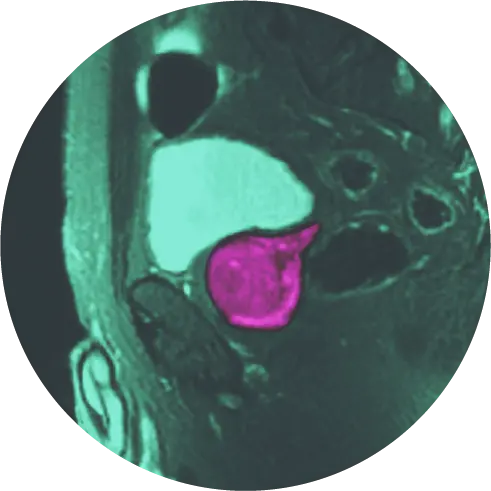Accurate Active Surveillance
Prostate Cancer Surveillance with mpMRI
Active Surveillance with mpMRI
Multi-parametric magnetic resonance imaging (mpMRI) is used in prostate cancer screening to detect and pinpoint the location of tumors or lesions within the prostate. mpMRI images help predict disease progression, which aids significantly in helping you and your doctor determine the best course of action for treatment. In some cases, mpMRI can rule out prostate cancer, avoiding the need for a prostate biopsy. It is estimated that mpMRI can increase the detection of clinically significant disease over other methods by 50% and reduce the number of unnecessary biopsies by one-third.
For men with slower-growing cancers, mpMRI allows for more confident active surveillance or watchful waiting.
ACTIVE SURVEILLANCE (AS)
is appropriate for younger men with low risk cancer who wish to postpone or avoid definitive treatment, or older men for whom the cancer may never cause a problem. Typically, patients will have a DRE and PSA every 3 – 6 months and a biopsy once a year.
WATCHFUL WAITING (WW)
is for men who have low risk cancer and a life expectancy of less than 10 years or have a history of serious health problems that may make some treatments too risky. Typically, patients will have a DRE and PSA test every 6 – 12 months. Hormone therapy may be used if the cancer begins to spread and the patient becomes symptomatic.
WATCH: The inventor of the PSA test, Dr. Richard J. Ablin and his long-time friend, HALO Dx Chief Research Officer, Bernadette Greenwood explain the evolution of the PSA test over the past several decades and the key role it still plays prostate cancer and BPH (benign prostatic hypertrophy) screening today.
Benefits
- mpMRIs ARE NON-INVASIVE
Patients who elect Watchful Waiting or Active Surveillance can get a baseline study performed to make sure they are truly a good candidate for expectant management. - mpMRIs CAN BE REPEATED
For men on active surveillance or watchful waiting who see a change in PSA numbers or DRE, an mpMRI is an easy, noninvasive way to check if there has been a change in prostate cancer progression. - ACCURATE GLEASON SCORE
When used for biopsy, mpMRI facilitates a targeted approach with more accurate results that help determine who is right for AS or AW, and who needs more definitive treatment.
mpMRI-Guided Biopsy with Active Surveillance
Men on Active Surveillance may not need an immediate TRUS biopsy if their PSA starts to rise. The way to overcome the shortcomings of conventional PSA/biopsy monitoring is an mpMRI of the prostate. This is the best way to conduct prostate imaging – showing the size, shape, location and aggression level of prostate cancer.
If a suspicious area is found on the multi-parametric MRI scan, we can perform an MRI-guided biopsy that is targeted to the suspicious area. A targeted mpMRI-guided biopsy provides greater accuracy in diagnosis with fewer needle cores than traditional ultrasound guided approach, resulting in less pain and a lower risk of infection.

Updated AUA Policy Statement
While only a biopsy can diagnose cancer, mpMRI imaging with a multi-parametric approach can assist with the characterization of areas within the gland that may warrant biopsy. Given the utility of mpMRI, the AUA recommends an MRI for men with abnormal PSA and BEFORE biopsy.

Update of the Standard Operating Procedure on the Use of Multiparametric Magnetic Resonance Imaging for the Diagnosis, Staging and Management of Prostate Cancer
Schedule a Consultation
Submit this form and we will contact you, usually within 24 hours, to answer your Prostate screening, diagnosis, and treatment questions.



